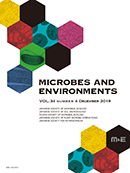
- |<
- <
- 1
- >
- >|
-
Masanori Toyofuku, Yousuke Kikuchi, Azuma TaokaArticle type: Minireview
2022Volume 37Issue 6 Article ID: ME22083
Published: 2022
Released on J-STAGE: December 09, 2022
JOURNAL OPEN ACCESS FULL-TEXT HTMLBacteria communicate through signaling molecules that coordinate group behavior. Hydrophobic signals that do not diffuse in aqueous environments are used as signaling molecules by several bacteria. However, limited information is currently available on the mechanisms by which these molecules are transported between cells. Membrane vesicles (MVs) with diverse functions play important roles in the release and delivery of hydrophobic signaling molecules, leading to differences in the dynamics of signal transportation from those of free diffusion. Studies on Paracoccus denitrificans, which produces a hydrophobic long-chain N-acyl homoserine lactone (AHL), showed that signals were loaded into MVs at a concentration with the potential to trigger the quorum sensing (QS) response with a “single shot” to the cell. Furthermore, stimulating the formation of MVs increased the release of signals from the cell; therefore, a basic understanding of MV formation is important. Novel findings revealed the formation of MVs through different routes, resulting in the production of different types of MVs. Methods such as high-speed atomic force microscopy (AFM) phase imaging allow the physical properties of MVs to be analyzed at a nanometer resolution, revealing their heterogeneity. In this special minireview, we introduce the role of MVs in bacterial communication and highlight recent findings on MV formation and their physical heterogeneity by referring to our research. We hope that this minireview will provide basic information for understanding the functionality of MVs in ecological systems.
View full abstractDownload PDF (1489K) Full view HTML
-
Shinsuke Shigeto, Norio TakeshitaArticle type: Minireview
2022Volume 37Issue 6 Article ID: ME22006
Published: 2022
Released on J-STAGE: April 07, 2022
JOURNAL OPEN ACCESS FULL-TEXT HTMLFilamentous fungi grow by the elongation of tubular cells called hyphae and form mycelia through repeated hyphal tip growth and branching. Since hyphal growth is closely related to the ability to secrete large amounts of enzymes or invade host cells, a more detailed understanding and the control of its growth are important in fungal biotechnology, ecology, and pathogenesis. Previous studies using fluorescence imaging revealed many of the molecular mechanisms involved in hyphal growth. Raman microspectroscopy and imaging methods are now attracting increasing attention as powerful alternatives due to their high chemical specificity and label-free, non-destructive properties. Spatially resolved information on the relative abundance, structure, and chemical state of multiple intracellular components may be simultaneously obtained. Although Raman studies on filamentous fungi are still limited, this review introduces recent findings from Raman studies on filamentous fungi and discusses their potential use in the future.
View full abstractDownload PDF (1854K) Full view HTML
- |<
- <
- 1
- >
- >|